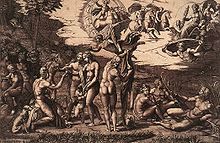Marcantonio Raimondi

Marcantonio Raimondi (* around 1475 in Agini; † around 1534 in Bologna ?) Was an Italian engraver of the Renaissance . He produced over 300 copper engravings based on the works of contemporary painters as well as works of art from antiquity, thus establishing the artistic branch of reproducing works of art using copper engravings .
Life
Raimondi was the son of a goldsmith from Bologna and, according to Giorgio Vasari , was instructed in the art of copper engraving by the painter, medalist and goldsmith Francesco Francia in Bologna . His interest in works of art from antiquity was stimulated by his stay in the vicinity of the Bolognese humanists. There he was friends with the poet Giovanni Achillini , who owned a number of ancient medals and whom he portrayed with an engraving.
He continued his education using Albrecht Dürer's engravings and woodcuts , which were highly valued and widespread in Renaissance Italy. Between 1505 and 1510 he copied about 80 graphics by Dürer, including his signature, which prompted Dürer to travel to Italy to take legal action against the unauthorized reproductions. In 1506 the first copyright litigation in art history took place in Venice . Raimondi was only convicted of illegally using Dürer's signature, but not of copying the woodcuts themselves. Further models for perfecting his technique were sheets by Lucas van Leyden .
During a stay in Florence he made two engravings after Michelangelo's cardboard for his fresco Battle of Cascina .

From 1510 Raimondi lived and worked in Rome, where he met Raffael , for whom he reproduced a painting, Dido , for the first time in the same year . From then on there was an intensive collaboration between the two artists. From this point on, Raimondi worked almost exclusively for Raffael and produced a large number of engravings based on the painter's drawings, cardboard boxes and paintings. These reproductions were a prerequisite for the widespread appreciation and high level of awareness that Raphael enjoyed in large circles in Italy and beyond the Alps. A number of the meanwhile destroyed or lost works of Raphael is known only through his reproductions, as well as drafts for paintings that were never executed.
After the modi , 16 erotic drawings by Giulio Romano , for which Pietro Aretino wrote the sonetti lussuriosi , he made engravings. This earned him a stay in prison in 1524, from which he was only released at the request of Cardinal Ippolito de 'Medici and the sculptor Baccio Bandinelli .
Raimondi's flourishing company was destroyed by the Sacco di Roma of 1527, as he could neither find clients nor buyers for his graphic production. According to Vasari , he had to flee from the Spanish Soldateska, possibly he went to Bologna. From now on his traces will be lost, after 1527 no more works can be reliably proven.
meaning
Raimondi's work, its themes and the technical perfection he achieved, for example in the production of chiaroscuro effects, had a great influence on future generations of engravers, whose main subject was the reproduction of works of art. Raimondi and the artists trained in his workshop contributed to spreading knowledge of iconography and the splendid achievements of Italian painting of their time and making it widely known.
Remarks
Web links
- Works by Marcantonio Raimondi at Zeno.org .
- Illustrations
- Engravings in the Fine Arts Museum San Francisco
| personal data | |
|---|---|
| SURNAME | Raimondi, Marcantonio |
| ALTERNATIVE NAMES | Raimondi, Marco Antonio; Raimondi, Marc Anton |
| BRIEF DESCRIPTION | Italian Renaissance engraver |
| DATE OF BIRTH | around 1475 |
| PLACE OF BIRTH | uncertain: Agini near Bologna |
| DATE OF DEATH | around 1534 |
| Place of death | uncertain: Bologna |

